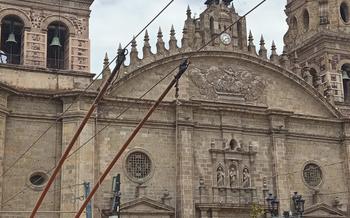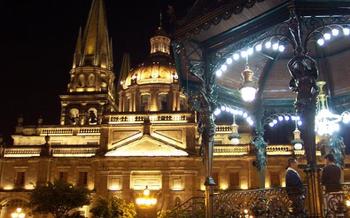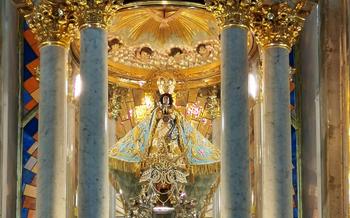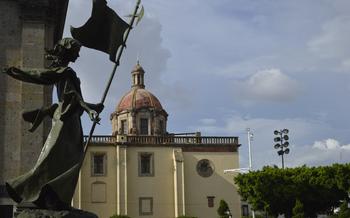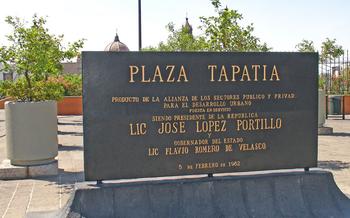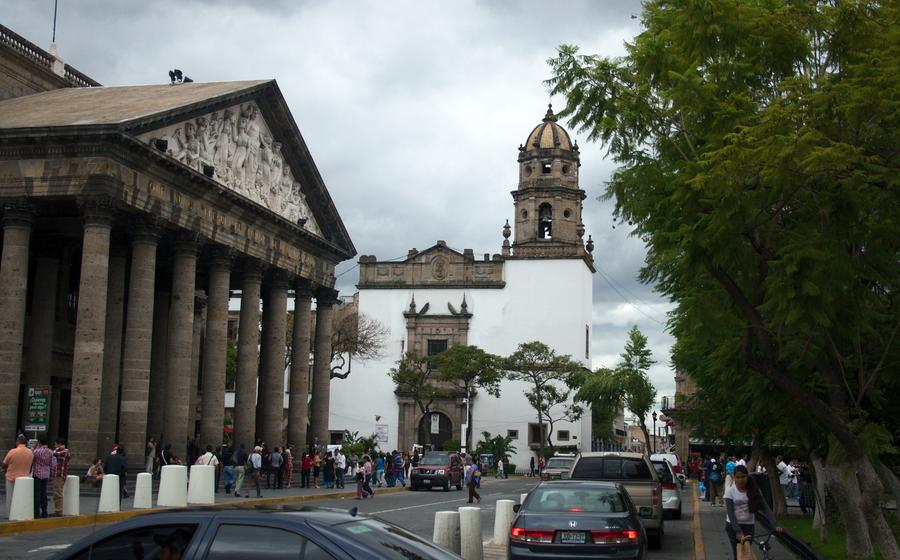
Templo de San Agustín
- Location and Accessibility: Finding the Templo de San Agustín
- Exploring the Facade: A Symphony of Detail
- Stepping Inside: A Sanctuary of Art and Devotion
- Discover the Altarpiece: A Testament to Craftsmanship
- Admiring the Murals: Vibrant Expressions of Faith
- Exploring the Chapel of Our Lady of Zapopan: A Sacred Space
- Uncovering the Crypt: A Hidden Realm Beneath the Church
- Attending Mass and Religious Services: A Spiritual Experience
- Enjoying the Surroundings: A Vibrant Neighborhood
- Capturing Memories: Photography and Videography
- Insider Tip: Unforgettable Views from the Rooftop Terrace
Location and Accessibility: Finding the Templo de San Agustín
The Templo de San Agustín is located in the heart of Guadalajara's historic center, making it easily accessible on foot or by public transportation. Its exact address is Calle San Agustín 173, Guadalajara, Jalisco, Mexico. To get there by public transportation, you can take the Macrobús line and hop off at the Templo de San Agustín station. The church is situated near several notable landmarks, including the Plaza de Armas, the Guadalajara Cathedral, and the Palacio de Gobierno. If you're traveling by car, limited street parking is available in the surrounding area.
Exploring the Facade: A Symphony of Detail
The facade of the Templo de San Agustín is a masterpiece of Baroque architecture, showcasing intricate details and exquisite craftsmanship. Its design is a harmonious blend of Spanish and Mexican influences, featuring a dramatic central arch flanked by two smaller arches, each adorned with elaborate carvings. The facade is further embellished with a profusion of sculptures, medallions, and reliefs, depicting scenes from the Bible and the lives of saints.
The sculptures on the facade are particularly noteworthy, showcasing the skill and artistry of the Baroque sculptors. They depict a variety of figures, including angels, saints, and biblical characters, each with their own unique expressions and poses. The weathering and aging of the facade have added a layer of patina to the sculptures, lending them a sense of history and authenticity.
One of the most striking features of the facade is its central arch, which is framed by two massive pilasters and topped by a broken pediment. The tympanum of the arch features a relief depicting the Assumption of the Virgin Mary, surrounded by a chorus of angels. The attention to detail in this relief is simply breathtaking, with each angel meticulously carved to convey a sense of movement and emotion.
Overall, the facade of the Templo de San Agustín is a testament to the artistic brilliance and devotion of the Baroque era. It is a work of art in its own right, inviting visitors to marvel at its intricate details and immerse themselves in its rich symbolism.
Stepping Inside: A Sanctuary of Art and Devotion
Entering the Templo de San Agustín is like stepping into a sanctuary of art and devotion. The interior, bathed in soft, diffused light filtering through stained glass windows, exudes an atmosphere of serenity and reverence. The layout of the church is traditional, with a central nave flanked by side aisles, all converging towards the elaborate main altar. The dimensions of the interior are impressive, with soaring ceilings and a spacious layout that allows for a sense of awe and grandeur.
Key elements of the interior include the altarpieces, pulpit, and choir, each a masterpiece of craftsmanship and artistic expression. The main altarpiece, a testament to Baroque artistry, dominates the sanctuary with its intricate carvings, gold leaf embellishments, and vibrant paintings depicting scenes from the life of Christ and the saints. The pulpit, an ornate structure adorned with reliefs and sculptures, serves as a focal point for sermons and teachings. The choir, located above the main entrance, adds to the acoustics of the church and provides a platform for the harmonious voices of the choir during religious services.
Notable works of art and religious imagery abound throughout the interior of the Templo de San Agustín. Murals grace the walls and ceilings, depicting biblical scenes, the lives of saints, and allegorical representations of faith and devotion. The church is also home to a collection of sculptures, paintings, and other artifacts that tell the story of its history and significance. The overall atmosphere is one of deep spirituality and devotion, inviting visitors to pause, reflect, and connect with their inner selves.
Discover the Altarpiece: A Testament to Craftsmanship
The main altarpiece of the Templo de San Agustín is a breathtaking masterpiece, a testament to the exceptional craftsmanship and artistry of its creators. Towering over the sanctuary, this colossal structure commands attention with its intricate carvings, opulent ornamentation, and vibrant colors.
Crafted from fine wood and adorned with glistening gold leaf, the altarpiece is a symphony of Baroque extravagance. Its central panel features a detailed narrative scene depicting the life and miracles of Saint Augustine, the church's patron saint. The intricate carvings showcase the remarkable skills of the artisans, capturing the emotions and expressions of the figures with lifelike precision.
The altarpiece is a treasure trove of symbolism and iconography. Each element, from the angels and saints to the intricate floral motifs, holds a deeper meaning, reflecting the theological and spiritual significance of the church.
Over the centuries, the altarpiece has undergone meticulous restoration efforts to preserve its original grandeur. The painstaking work of skilled conservators has ensured that this masterpiece continues to shine as a testament to the artistry and devotion of those who created it.
Admiring the Murals: Vibrant Expressions of Faith
The Templo de San Agustín is not only a showcase of architectural grandeur, but it also houses a treasure trove of stunning murals that adorn its interiors. These vibrant artworks, executed with meticulous detail and artistry, captivate the eyes and transport visitors to a realm of divine narratives and spiritual reflections.
Located in various sections of the church, including the dome, the main altar, and the side chapels, the murals tell stories from the Bible, depict the lives of saints, and showcase scenes from the history of the church. Each mural is a masterpiece in its own right, showcasing the talent and devotion of the artists who created them.
The artistic styles and techniques used in the murals vary, ranging from the intricate realism of the Renaissance to the expressive brushstrokes of the Baroque period. The murals are a testament to the enduring legacy of Mexican art and the deep-rooted faith that permeates the country's culture.
The themes and stories depicted in the murals are diverse and captivating. From the serene beauty of the Annunciation to the dramatic scenes of the Crucifixion, the murals offer a visual journey through the key moments of Christian history. They serve as a powerful reminder of the power of faith and the enduring significance of religious narratives in Mexican society.
The murals in the Templo de San Agustín are not mere decorations; they are integral to the spiritual ambiance of the church. They invite visitors to contemplate the mysteries of faith, to connect with the divine, and to find solace and inspiration within the sacred space. These stunning artworks are a testament to the enduring power of art to transcend time, communicate spiritual messages, and inspire the hearts and minds of believers.
Exploring the Chapel of Our Lady of Zapopan: A Sacred Space
Within the Templo de San Agustín, a sacred space holds a special place in the hearts of the faithful: the Chapel of Our Lady of Zapopan. Dedicated to the revered Virgin of Zapopan, this chapel exudes an aura of devotion and spiritual significance.
The history of the chapel is intertwined with the arrival of the Virgin's image in Guadalajara in the 16th century. Originally housed in the nearby town of Zapopan, the image gained widespread devotion and was eventually brought to the Templo de San Agustín, where it became the focus of veneration.
The chapel's architectural features reflect its importance. Its intricate design and ornate decorations create a sanctuary that invites contemplation and prayer. The walls are adorned with beautiful murals depicting scenes from the Virgin's life and miracles, adding to the chapel's spiritual ambiance.
Throughout the year, the chapel hosts special events and celebrations dedicated to the Virgin of Zapopan. The most notable is the annual pilgrimage, where thousands of devotees gather to honor the Virgin and witness the procession of her image through the streets of Guadalajara.
Visiting the Chapel of Our Lady of Zapopan is a unique opportunity to immerse oneself in the deep-rooted devotion to the Virgin of Zapopan and experience the spiritual essence of this sacred space.
Uncovering the Crypt: A Hidden Realm Beneath the Church
Beneath the Templo de San Agustín lies a hidden realm, a crypt that holds secrets and stories from a bygone era. While its existence may be unknown to many, those who venture into this subterranean space will be rewarded with a glimpse into the church's rich history and religious significance.
The crypt is believed to have been constructed during the early 17th century, serving as a burial ground for prominent figures associated with the church and the surrounding community. Over time, it became a repository of religious artifacts, bones, and relics, each piece telling a unique tale of faith, devotion, and mortality.
In the 19th century, the crypt underwent renovations and restoration efforts, revealing a wealth of well-preserved artifacts and skeletal remains. Archaeological studies conducted during this time shed light on the diverse backgrounds and social status of those interred within the crypt, providing valuable insights into the social dynamics and religious practices of Guadalajara's past.
Although the crypt is not typically open to the public due to preservation concerns, special arrangements can sometimes be made for guided tours or research purposes. Visitors who are granted access will encounter a dimly lit, atmospheric space, where the echoes of history linger in the air.
Exploring the crypt is an opportunity to delve deeper into the Templo de San Agustín's rich tapestry of stories and traditions. It is a place where the past and present converge, offering a unique glimpse into the lives and beliefs of those who have shaped this sacred space.
Attending Mass and Religious Services: A Spiritual Experience
The Templo de San Agustín is a place of deep spiritual significance for the people of Guadalajara, and attending a mass or religious service here offers a unique opportunity to immerse yourself in the local culture and traditions. Regular masses are held throughout the week, with special services and celebrations taking place on Sundays and feast days.
Before attending a service, it's important to dress respectfully and follow the local customs. Women are expected to cover their shoulders and knees, and men should avoid wearing shorts or tank tops. Upon entering the church, it's customary to dip your fingers in the holy water font and make the sign of the cross.
During the service, you'll witness the vibrant expressions of faith and devotion that characterize Mexican Catholicism. The congregation sings hymns with fervor, and the air is filled with the scent of incense and the flickering of candles. Whether you're a devout believer or simply seeking a deeper understanding of the local culture, attending a mass or religious service at the Templo de San Agustín is a truly immersive and enriching experience.
Enjoying the Surroundings: A Vibrant Neighborhood
Beyond the walls of the Templo de San Agustín lies a vibrant neighborhood rich in history, culture, and local charm. As you step out of the church, take a moment to explore the surrounding streets and discover the hidden gems that await.
Just a short stroll away, you'll find the Plaza de los Mariachis, a lively square where traditional Mexican musicians gather to serenade passersby with their enchanting melodies. Grab a seat at one of the outdoor cafes, savor a refreshing beverage, and soak in the lively atmosphere as the rhythms of mariachi music fill the air.
For a taste of local cuisine, head to Mercado Libertad, a bustling market where vendors display an array of fresh produce, traditional dishes, and handcrafted souvenirs. Indulge in the flavors of authentic Mexican street food, sample exotic fruits, or browse the colorful stalls for unique treasures to take home.
History buffs will appreciate the Museo Regional de Guadalajara, which houses an extensive collection of artifacts and exhibits that showcase the rich cultural heritage of the region. Learn about the indigenous civilizations that once inhabited the area, admire pre-Hispanic pottery and sculptures, and trace the evolution of Guadalajara's colonial and modern history.
The surrounding neighborhood also boasts a number of charming boutiques, art galleries, and independent shops where you can find unique souvenirs, handcrafted goods, and locally made products. Take advantage of the opportunity to support local artisans and bring home a piece of Guadalajara's vibrant culture.
Capturing Memories: Photography and Videography
The Templo de San Agustín is a photographer's paradise, with its captivating architecture, intricate details, and awe-inspiring interiors. While capturing the beauty of this sacred space, it is essential to be respectful and mindful of the religious significance and atmosphere of the church.
Photography and videography are permitted inside the church, but with certain guidelines and restrictions:
-
Flash photography and tripods are generally not allowed as they can be disruptive during religious services and cause damage to sensitive artifacts.
-
Be discreet and avoid disturbing other visitors or worshippers by using silent camera modes and moving around quietly.
-
Obtain permission from the church authorities if you plan to take photos or videos for commercial or professional purposes.
-
When taking photos of people, always ask for their consent before capturing their image.
-
Be mindful of the privacy of others and avoid taking photos or videos that may be intrusive or disrespectful.
-
Respect the sanctity of the religious space by refraining from taking photos or videos during ongoing services or rituals.
By following these guidelines, you can capture the beauty of the Templo de San Agustín while respecting the sacred nature of this architectural masterpiece.
Insider Tip: Unforgettable Views from the Rooftop Terrace
Many visitors to the Templo de San Agustín are unaware of the hidden gem that lies above the church's vaulted ceilings. A magnificent rooftop terrace offers breathtaking panoramic views of Guadalajara, providing a unique perspective on the city's vibrant cityscape.
To access this secret vantage point, visitors can inquire at the church's main office about the availability and conditions for rooftop access. The terrace is typically open during daytime hours, but it's advisable to check in advance to avoid disappointment.
The best time to visit the rooftop is undoubtedly around sunset, when the sky transforms into a canvas of vibrant colors, casting a warm glow over the city's landmarks. As the sun dips below the horizon, the twinkling lights of Guadalajara illuminate the cityscape, creating a mesmerizing spectacle that will leave you spellbound.
From the rooftop, you can admire iconic landmarks such as the Guadalajara Cathedral, the Degollado Theater, and the Hospicio Cabañas, all framed against the backdrop of the surrounding mountains. It's the perfect spot to capture stunning photographs and create lasting memories of your visit to this historic city.
So, if you're looking for an unforgettable experience that goes beyond the church's interior, be sure to inquire about access to the rooftop terrace. It's a hidden gem that will reward you with breathtaking views and a unique perspective on the beauty of Guadalajara.
